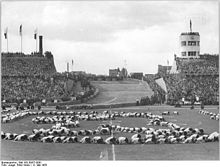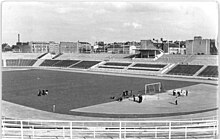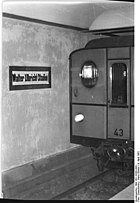World Youth Stadium
| World Youth Stadium | |
|---|---|

|
|
| The stadium for the opening of the 1951 World Festival | |
| Data | |
| place |
|
| Coordinates | 52 ° 32 '2 " N , 13 ° 22' 36" E |
| start of building | January 20, 1950 |
| opening | May 20, 1950 |
| Renovations | 1951, 1973 |
| demolition | 1992 |
| surface | Natural grass |
| architect | Selman Selmanagić , Reinhold Lingner |
| capacity | 70,000 (later 50,000) |
| Events | |
|
|
The World Youth Stadium was a sports facility in the Mitte district of East Berlin . The stadium, which opened in 1950 as the Walter Ulbricht Stadium , was one of the largest athletics and football stadiums in the GDR with an initially 70,000 (later 50,000) audience . It was demolished in 1992 as part of Berlin's bid for the 2000 Summer Olympics . From October 2006 to February 2018, the new headquarters of the Federal Intelligence Service (BND) was built on the area in the Mitte district .
Location and facilities
The stadium was located in the western part of what was then the Mitte district (which today, together with the former Tiergarten and Wedding districts, forms the "new" Mitte district) on the former site of the police stadium . It bordered Chausseestrasse in the east, Habersaathstrasse in the south (Kesselstrasse until 1951) and residential areas along Scharnhorststrasse and Boyenstrasse in the north and west.
In addition to the main stadium, there were other soccer fields, nine tennis and two pitcher courts, a heavy athletics facility and a functional building with sanitary, administrative and restaurant rooms . With a total area of 131,000 square meters, the area was the largest sports facility in the Mitte district.
history
Before the area was used for sporting events, it was primarily used for military purposes. A parade ground was created here around 1820 before the cockchafer barracks were built in the middle of the 19th century . After the First World War , the Berlin police took over the land and built on it in 1929 (during the Second World War, but again destroyed) Police Stadium .
In its place, after the ruins of the cockchafer barracks had been removed in 1950 on the occasion of the first meeting of young people in Germany according to plans by the architects Reinhold Lingner and Selman Selmanagić, a new stadium was built on May 20, 1950 by the then general secretary of the Central Committee of the SED Walter Ulbricht was opened. It was to this that the arena owed its first name "Walter Ulbricht Stadium". In popular parlance, the stadium was later given the name “Zickenwiese” because of Ulbricht's beard.
A year later, the architects built the stadium for the III. World Festival again. A little later, the area, regarded as a symbol of the GDR government, was occupied by thousands of demonstrators during the popular uprising of June 17, 1953 . They damaged or destroyed lettering and emblems as symbols of the hated GDR government as well as benches, walls and window panes.
For the 10th World Festival , the sports facility was rebuilt according to plans by Jörg Piesel and Rolf Tümmler , with the number of spectators reduced to 50,000 (including 20,000 seats). It was reopened on July 28, 1973 as the World Youth Stadium . The previous namesake Walter Ulbricht was replaced in 1971 by Erich Honecker as SED General Secretary and was now seeing his name being erased from the GDR public. Ulbricht died during the Games after having had a stroke shortly before. Strange was with the name change of the stadium, the accompanying name change in neighboring metro station was visible only to West Berlin population, since it is at this station to one of the many created with the construction of the Wall in Berlin ghost stations concerned, while from the West Berlin subway (in this case subway line 6 ), but could not be used as a stop.
use

The stadium was used as a venue for various athletics competitions, major political events or football games. From 1952 to 1964 it was also the stage destination and starting point of the International Peace Tour . The final of the FDGB Cup was held here as early as 1950 . Between 1975 and 1989 this took place regularly in the World Youth Stadium. In addition, the GDR national team used the arena for 13 official international matches. The unofficial duel between the East German national team and the top Soviet club Dynamo Moscow at the opening of the World Youth Festival on August 5, 1951 recorded a record 70,000 spectators.
The SC Dynamo Berlin soccer team (from which BFC Dynamo emerged in 1966 ) played their home games in the Walter Ulbricht Stadium until 1961 . FC Vorwärts Berlin, which was based in Berlin until 1971, also moved here for some European Cup games. So saw z. B. 1959 65,000 spectators the duel forward against Wolverhampton Wanderers . Starting in 1976, all were Oberliga - derbies between the BFC Dynamo and its local rivals 1. FC Union Berlin played in the World Youth Stadium. The 1. FC Union also had to move to the middle for a few home games in 1981 because the home stadium at An der Alten Försterei was being renovated.
The World Youth Stadium also served as a venue for some special German-German duels. On December 25, 1951, it was the venue for the first of two so-called “reconciliation duels” between the West and East Berlin Football Associations. In front of 55,000 spectators, the East Berlin city selection won 3: 2 over the city selection of West Berlin. After the return match on December 26, 1954 in the West Berlin Post Stadium (both teams drew 3: 3), on May 11, 1955, in front of 70,000 spectators in the Ulbricht Stadium, a game of an overall Berlin city selection against a team from Prague , which was won 1-0. Another match of the selection (this time in the Berlin Olympic Stadium ) did not take place due to political tensions.
Another politically explosive encounter took place on September 16, 1959, when the GDR national team competed against the West German amateur selection . This encounter had become necessary because the International Olympic Committee demanded the deployment of an all-German team , but the respective football associations ( DFV and DFB ) could not find a solution for a mixed team. Therefore, by order of the respective National Olympic Committee, the participants from both countries should be determined in a round trip. The first leg in the Walter Ulbricht Stadium as well as the second leg in the Düsseldorf Rheinstadion took place in front of empty stands and almost completely sealed off from the public. Both games were won by the FRG selection (2-0 in Berlin and 2-1 in Düsseldorf).
demolition

The demolition of the now slightly dilapidated structure began in mid-1992, as a 15,000-seat sports arena was to be built for the planned 2000 Olympic Games in Berlin. The costs for the demolition (more than 27,000 cubic meters of rubble were removed) amounted to 32 million marks. Since Sydney was not awarded the contract, the planned arena was not built and the area lay fallow from 1993 onwards. In the following years it was used for various purposes (including as a golf, beach volleyball and mountain biking facility) until the Federal Intelligence Service started building its new headquarters on the site in October 2006 .
literature
- Joachim Schulz, Werner Gräbner: Architectural Guide GDR, Berlin, capital of the GDR . VEB Verlag für Bauwesen, Berlin 1974, p. 68
- Christian Wolter : Lawn of passion. The football fields of Berlin. History and stories. Edition Else, Berlin 2011, ISBN 978-3-00-036563-8 , pp. 220-225.
Web links
- Photos and general information ( Memento from May 18, 2011 in the Internet Archive )
- World Youth Stadium . In: District lexicon of the Luisenstädtischer Bildungsverein
- schoelkopf.com Pictures of the stadium
Individual evidence
- ↑ A few sizes smaller; District wants sport, leisure and living on Chausseestrasse Mitte . In: Berliner Zeitung , August 11, 1994.
- ↑ Chausseestrasse - headquarters of the BND; History. (No longer available online.) Senate Department for Urban Development, archived from the original on November 8, 2011 ; Retrieved January 15, 2009 . Info: The archive link was inserted automatically and has not yet been checked. Please check the original and archive link according to the instructions and then remove this notice.
- ^ Mathias Klappenbach: Riot on the Zickenwiese . In: Der Tagesspiegel , June 15, 2003
- ^ Transit through the East . ( Memento of the original from December 14, 2011 in the Internet Archive ) Info: The archive link was inserted automatically and has not yet been checked. Please check the original and archive link according to the instructions and then remove this notice. berliner-untergrundbahn.de
- ↑ history . In: Berliner Zeitung , March 2, 1996.
- ↑ Thomas Jasper: History. (No longer available online.) In: www.fcvfrankfurt.de . Archived from the original on September 26, 2009 ; Retrieved October 21, 2009 . Info: The archive link was inserted automatically and has not yet been checked. Please check the original and archive link according to the instructions and then remove this notice.
- ↑ René Wiese: When the West tried the one-two with the East . In: Der Tagesspiegel , August 3, 2006.
- ↑ Jutta Braun, René Wiese: German-German ghost games . In: Der Tagesspiegel , September 18, 2009.
- ↑ A few sizes smaller; From the parade ground to the wasteland center . In: Berliner Zeitung , August 11, 1994.


